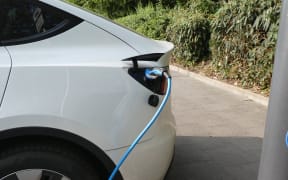Officials are looking at better ways of choosing who gets the power in the face of occasional shortages - like Friday's - and relentlessly growing and competing demands.
The Electricity Authority (EA) told RNZ it was "considering improving the prioritisation processes to filter out more speculative applications" to connect to power networks.
This is among a long list of measures the authority, the Ministry of Business, Innovation and Employment (MBIE) and others say they have begun work on to make the country's electricity supply better.
But a new Ministry of Energy will not be among them.
"The government has no plans to create a Ministry of Energy," Energy Minister Simeon Brown told RNZ late on Thursday.
The largest distributor, Vector in Auckland, has its own long list of connections it has to make and networks it has to build to keep up.

The Electricity Authority (EA) told RNZ it was "considering improving the prioritisation processes to filter out more speculative applications" to connect to power networks. Photo: AFP
It has warned the country needs "a coordinated strategy and a plan" for critical decisions, such as around the new demands of data centres and electric vehicle (EV) charging.
"We're not saying we want to interfere with the market or anything, but we have to have visibility so we can manage the impact of them," chief executive Simon Mackenzie said.
"You've got multiple operators coming in and trying to provide new solutions to customers, but they all have to still be coordinated, so that the networks can manage them and ... you're not building network unnecessarily."
The government had an overarching Electrify NZ programme focused on boosting investment in renewable electricity generation. Just how that will be done, and just who will do it, are among the big questions.
MBIE said there was "no work underway to create a Ministry of Energy or a 'nationwide long-term plan'."
Planning and regulating was widely dispersed across MBIE, the Energy Efficiency and Conservation Authority, EA and the Commerce Commission.
The commission later this year will reset how much revenue is available to the country's 29 distributors - Vector by far the largest - to invest in network upgrades.
EA determines how prices are set to access the networks.
"We are hearing that EV charge point operators believe they face high costs and difficult processes for new connections from distribution businesses," MBIE general manager of energy markets Justine Cannon told RNZ on Thursday.
Coincidentally, EA put out its next steps on distribution pricing reform, including connection costs, just on Tuesday.
"We want distribution pricing to send the right signals about the cost of the electricity that's being fed to homes and businesses," EA said online. It has set up a new group to consult with the industry.
The EA gave RNZ a long statement detailing a host of moves it was taking to boost "investment, innovation and transparency".
"We're already working with industry to determine what regulatory changes are needed to make it easier to connect load, like public EV charging stations," network pricing director Tim Sparks told RNZ.
A 'Supercharging EV Infrastructure Cross-Agency Taskforce' has been set up. Some users were facing "inefficiently high up-front charges that could act as a barrier to electrification", and the authority was working to counter that.
It was not all about making it easier; its work included the filter on "more speculative application", Sparks said.
On the big job of spreading out peak demand so networks did not have to be over-engineered, its work included improving visibility around how chargers or batteries and other smart devices were being used - what Vector has called for.
"Less poles and wires" could result from work on a 'flexibility services market' to encourage a wider spread of energy resources, including in more locations.
Vector's Mackenzie said other countries had renewable energy zones so "you don't have to upgrade big transmission systems to cater for something that's thousands of miles away from the load".
"That all comes under energy strategy," he said.
Brown said in a statement the government was pulling down regulatory barriers and overhauling rules that were a decade out of date. This included setting standards for smart devices to shift home charging away from network peaks.






